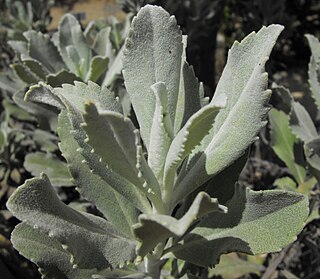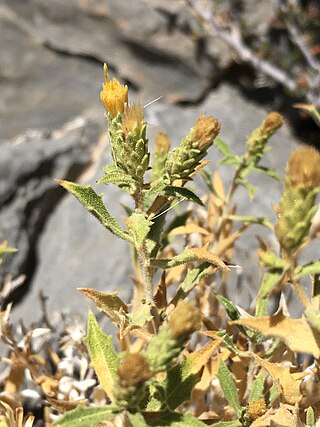
Frangula californica is a species of flowering plant in the buckthorn family native to western North America. It produces edible fruits and seeds. It is commonly known as California coffeeberry and California buckthorn.

Rhododendron occidentale, the western azalea or California azalea, is one of two deciduous Rhododendron species native to western North America. The western azalea is known to occur as far north as Lincoln and Douglas Counties in Oregon and as far south as the mountains of San Diego county. Typically found in the coastal ranges of western North America, it also grows in the Cascade and Sierra Nevada mountain ranges, but is not known east of them.

Machaeranthera is a genus of North American flowering plants in the family Asteraceae which are known by the common name tansyaster.

Hazardia is a small genus of North American flowering plants in the family Asteraceae. Plants in this genus may be called bristleweeds or goldenbushes.
Hazardia cana is a rare North American species of shrubs in the family Asteraceae known by the common names Guadalupe hazardia, San Clemente Island hazardia, or simply island hazardia. It is native to San Clemente Island, one of the Channel Islands of California, and to Guadalupe Island.

Hazardia detonsa is a rare species of shrub in the family Asteraceae known by the common name island bristleweed. It is endemic to the Channel Islands of California, having been found on 4 islands.

Hazardia squarrosa is a North American species of shrub in the family Asteraceae known by the common name sawtooth goldenbush. It is native to California in the United States and Baja California in Mexico.

Chrysothamnus viscidiflorus is an American species of shrub in the family Asteraceae known by the common names yellow rabbitbrush and green rabbitbrush.
Ericameria brachylepis is a North American species of flowering shrub in the family Asteraceae known by the common names chaparral goldenbush and boundary goldenbush.

Adiaphila brickellioides is a species of shrub in the family Asteraceae known by the common name brickellbush goldenweed. It is native to the Mojave Desert of California and Nevada, where it grows in rocky limestone habitat.
Solidago guiradonis is an uncommon species of goldenrod known by the common name Guirado goldenrod. It is native to the Central California Coast Ranges of central California, in southern San Benito and western Fresno Counties.

Tetradymia stenolepis is a species of flowering plant in the aster family known by the common name Mojave cottonthorn. It is native to the deserts around the intersection of Arizona, Nevada, and eastern California, where it grows in woodland and scrub habitat on sandy and gravelly substrates. It is a bushy shrub with many branches coated in woolly white fibers and growing to a maximum height just over a meter. The narrow leaves are 2 or 3 centimeters long and harden into straight, sharp spines. Clusters of woolly leaves grow near the spines. The inflorescence bears up to 7 flower heads which are each enveloped in four or five woolly phyllaries. Each head contains up to four or five tubular yellow flowers each around a centimeter long. The fruit is a hairy achene which may be nearly 2 centimeters long, including its pappus of long bristles.
Hazardia orcuttii is a rare North American species of flowering plant in the family Asteraceae known by the common names Orcutt's bristleweed and Orcutt's goldenbush. It is native to California in the United States and Baja California in Mexico. It can be found in one location in California, in the city of Encinitas. There, it is located in and near a protected zone known as the Manchester Conservation Area. In Baja California it can be found at 11 to 17 locations.

Arctostaphylos nortensis, common name Del Norte manzanita, is a shrub narrowly endemic to the mountains along the Oregon/California state line. It has been reported from only 3 counties: Del Norte County, California; and Curry and Josephine Counties in Oregon. The plant grows in chaparral and open forests at elevations of 400–600 m (1,300–2,000 ft), occasionally on serpentine.

Ericameria palmeri, or Palmer's goldenbush, is a North American species of flowering shrubs in the family Asteraceae. It is native to southern California in the United States and to the state of Baja California in Mexico.

Ericameria parishii, or Parish's rabbitbrush, is a western North American species of flowering plants in the family Asteraceae.
Hazardia ferrisiae is a Mexican species of shrub in the family Asteraceae. It has been found only in the state of Baja California in northwestern Mexico.

Adeia whitneyi, common name Whitney's bristleweed, is a North American species of shrub in the daisy family. It has been found only in the state of California in the western United States.

Hazardia rosarica is a species of flowering shrub in the family Asteraceae commonly known as the El Rosario goldenbush. Hazardia rosarica is a fragrant shrub characterized by its zigzagged branches, toothed glutinous leaves, and yellow flower heads of only disc flowers. This species is endemic to Mexico and is only found in the region near of the town of El Rosario in Baja California. It is usually found on north and east facing slopes and ridgetops close to the coast.
Hazardia vernicosa is a Mexican species of shrub in the family Asteraceae. It has been found only in the state of Baja California in northwestern Mexico, specifically near El Rosario. It has not been found in the United States although one of the Mexican populations is less than 10 km south of the international border.













